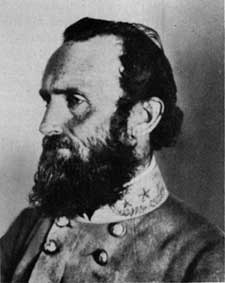|
FREDERICKSBURG and SPOTSYLVANIA COUNTY BATTLEFIELDS MEMORIAL National Military Park |
 |

Jackon's flank march, May 2, 1863.
(click
on image for an enlargement in a new window)
JACKSON APPEARS INTO THE FOREST
At a conference that night between Lee and Jackson it was decided that Jackson's corps would make the attack. A local guide was found who knew a seldom-used trail through the woods that would keep them out of sight of the Federals for most of the march. Lee would keep pressure on Hooker as best he could with his limited force until Jackson was in position. Stuart's cavalry was to screen the movement.
The Union Army's right flank was held by Howard's XI Corps, stretching west about a mile from Wilderness Church and generally facing south. East of Howard was Sickles' III Corps, with Slocum's XII and Couch's II curved around the Chancellorsville crossroads. Meade's V Corps held the left flank, with its own flank resting on the Rappahannock.
 Thomas J. Jackson. Courtesy, National Archives. |
Saturday, May 2, broke clear and hot. As the sun burned down, Jackson's column, 6 miles long, wound its way across the Union front. Shortly after the march began, Federal observers, posted atop tall trees, reported a heavy movement in front of Sickles. Hooker declared jubilantly, "Lee is in full retreat to wards Gordonsville."
Sickles requested permission to attack. But it took Hooker until noon to make up his mind, and then his orders were hesitant and timid. "Move out cautiously and harass the movement." The word "attack" was not even mentioned, and only Sickles was ordered to move. Strange orders, indeed, for a commanding general who earlier had informed his cavalry commander that the secret of success in battle is to "fight, fight, fight."
Sickles moved out with two divisions. About 2:30 p.m. he hit the Confederate rear guard near Catharine Furnace and killed or captured most of the 23d Georgia Regiment. But by 2:30 Jackson's leading regiment, the 5th Alabama, was already forming for the attack across the turnpike west of Hooker's right flank.
As the other Confederate regiments gradually came up and formed in the woods, the Union pickets were aware that something was afoot. Junior officers of the line tried to alert corps headquarters, but Howard, imbued with Hooker's belief that Lee was fleeing and convinced that the woods were too thick on his flank for a major assault, refused to take any action. At Army headquarters back at Chancellorsville, the warnings also went unheeded. In desperation, one officer in command of some pickets sent a final message to Howard that the enemy was forming in strength in the woods on his flank, and ended with, "For God's sake make disposition to receive him." About that time Hooker was informing Sedgwick: "We know the enemy is fleeing, trying to save his trains.
Shortly after 5 o'clock Jackson was ready. Many of the Union soldiers, their muskets stacked, were preparing supper, some were playing cards, others were sleeping. At the shouted orders the gray-clad regiments exploded out of the woods to the sound of the rebel yell and rolled up Hooker's right flank. Most of Howard's corps was quickly shattered into a frightened, disorganized mob and streamed back toward Chancellorsville. A soldier in the 13th Mass. Volunteers remembered that "along the road it was pandemonium; on the side of the road it was chaos."
In the shadows of dusk the initial charge lost its momentum as scattered Federal units were brought into line to stem the tide. Their alinement broken by the charge through the woods and the excitement of the attack, the Confederate regiments halted to reorganize. In the hope that he could continue the assault, Jackson himself went forward on the turnpike in the growing darkness to study the situation at firsthand. But in returning to his lines he was mistakenly shot and mortally wounded by his own men, ending any chance of another major attack before morning.

|
|
Last Modified: Mon, Dec 2 2002 10:00:00 am PDT |


